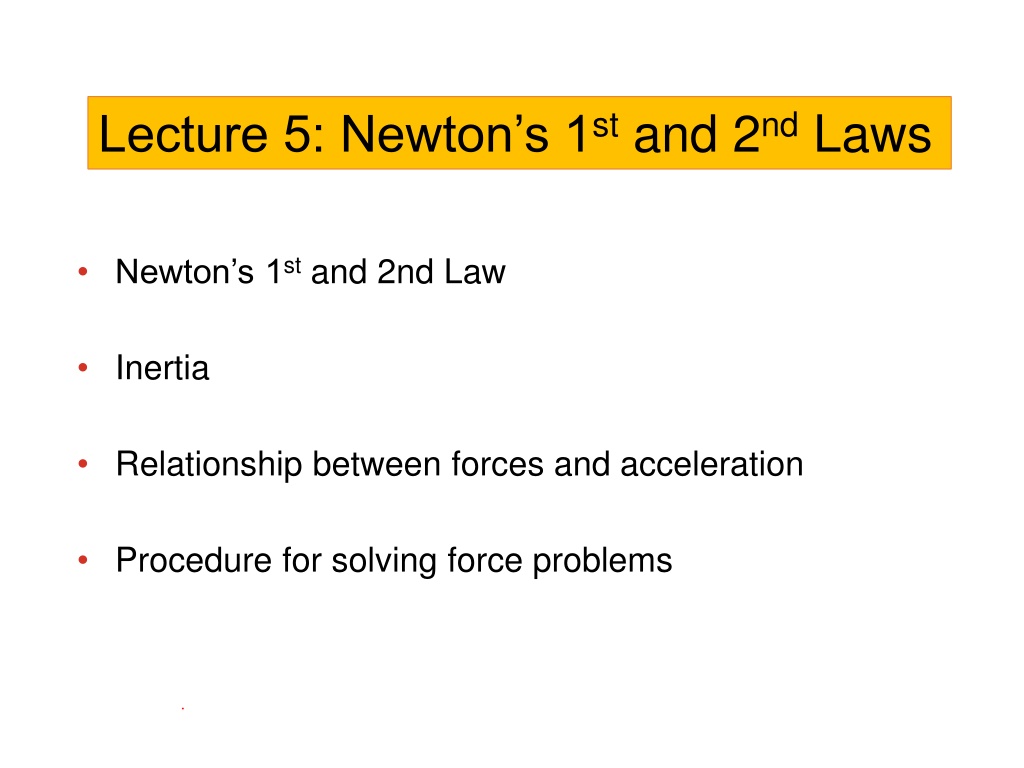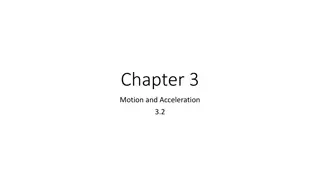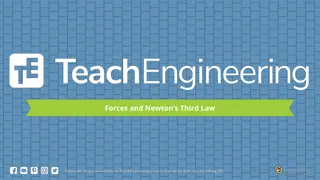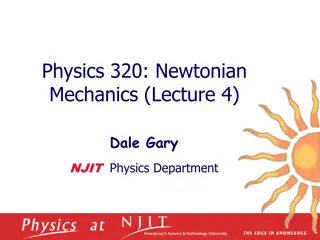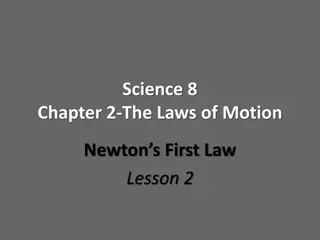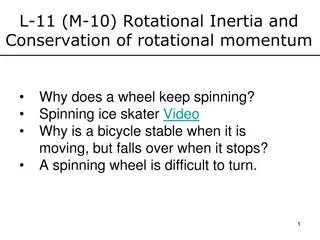Understanding Newton's Laws of Motion: Inertia, Forces, and Acceleration
Delve into the fundamentals of Newton's first and second laws of motion, exploring concepts such as inertia, the relationship between forces and acceleration, and the procedure for solving force problems. Discover how objects behave when left to themselves, and grasp the significance of forces in changing an object's state of motion. Engage with examples of different forces, learn about the nature of forces as pushes or pulls with magnitude and direction, and contemplate forces acting on objects in various scenarios. Challenge yourself with a discussion on the forces at play when a ball is thrown upwards, disregarding air resistance. Embrace the understanding that changes in velocity require force, whether it be to stop, start, change direction, or alter speed.
Download Presentation

Please find below an Image/Link to download the presentation.
The content on the website is provided AS IS for your information and personal use only. It may not be sold, licensed, or shared on other websites without obtaining consent from the author. Download presentation by click this link. If you encounter any issues during the download, it is possible that the publisher has removed the file from their server.
E N D
Presentation Transcript
Lecture 5: Newtons 1st and 2nd Laws Newton s 1stand 2nd Law Inertia Relationship between forces and acceleration Procedure for solving force problems
What is the natural state of an object left to itself? Aristotle: to be at rest. Galileo: to be in uniform motion with constant velocity.
Newtons 1st Law Law of Inertia Every body continues in its state of rest or of uniform speed in a straight line unless acted on by a nonzero force. If no external force acts on an object, its velocity remains constant: ? = 0 ? = ???????? * * Remember that velocity is a VECTOR, and has both direction and magnitude
Newtons 1st Law applied to cats A cat at rest remains at rest unless acted on by a nonzero force.
Examples for forces Gravity (weight) Spring force Tension (ball held by rope) Friction Push/Pull Electromagnetic forces
A force. is a push or pull acts on a object is a vector and has magnitude and direction
Stop to Think: Discussion Question You throw a small ball straight up. Disregarding any effect of air resistance, what forces are acting on the ball until it returns to the ground? A) a constant downward force of gravity only. B) its weight vertically downward along with a steadily decreasing upward force. C) a steadily decreasing upward force from the moment it leaves the hand until it reaches the highest point, beyond which there is a steadily increasing downward force of gravity.
A force. is a push or pull acts on a object is a vector and has magnitude and direction requires an agent is either a contact force or a long-range force (such as gravity)
Changes in velocity If ? = ???????? in magnitude and direction ? = 0 Changes in velocity such as Stopping (or starting) an object Changing direction of motion Increasing/decreasing speed require force.
Inertia Observation: Objects with greater weight are harder to accelerate. In deep space: no gravity, so no weight. But objects still have intrinsic resistance to acceleration. This resistance to changes in motion is called inertia, and the quantity of resistance is called massm.
Newtons 2nd Law If a net external force acts on a body, the body accelerates. ???? ? = ? ? = ? ? = ? ? *for object with constant mass ? ?2= ? Newton Unit: ??
Component version of Newtons 2nd Law *Net force also sometimes called resultant or total force ????= ? = ? ? * ????,? ? + ????,? ? = ?? ? + ?? ? = ??? ? + ??? ? ??= ??? ??= ??? Because the axes are orthogonal, we can separately equate the x-components and the y-components.
Weight force Earth s gravitational field exerts a force on objects. At Earth s surface: ?????= ?? ? = (?,????) with magnitude ? = 9.8 m/s2 Gravitational force on an object is called weight. ? = (mg, down) m in weight and m in Newton s second law are the same! Inertial mass = gravitational mass
Object in free fall If gravitational force is the only force acting on object: ?????= ?? = ?? ? = ? Free fall acceleration independent of mass. But: Even if object is not in free fall, the force of gravity acts on it.
Can we feel gravity? We can not feel the gravitational force. We can feel a normal force from the floor or seat. Spring scale shows normal force. If ? = 0: ? = ??
Apparent weight In an elevator that accelerates upwards: ??= ??+ ??= ??? +? + ?? = ? +? ? = ?(? + ?) Apparentweight more than real weight. Feels heavier If elevator accelerates downwards: ? = ? ? ? If cable breaks: ??= ?,? = 0 no sensation of weight* *but very bad upon impact
Inertial Reference Frames An inertial reference frame is a coordinate system in which Newton s laws are valid. Airplane cruising at constant velocity: A ball on the floor remains at rest relative to the airplane the plane is an inertial reference frame Airplane accelerating before take-off: A ball on the floor rolls to the back of the plane. No horizontal force acts on the ball, but it accelerates in the plane s coordinate system! the plane is not an inertial reference frame
Galilei Transformation Coordinate system 2 moving at constant ? with respect to coordinate system 1 Newton s Laws look the same!
Example A worker pushes a crate of mass M on a level frictionless surface by applying a constant pushing force of magnitude P at an angle with respect to the horizontal, as shown in the figure. Derive expressions for the acceleration of the crate and the magnitude of the normal force acting on the crate, in terms of relevant system parameters.
Summary of Litany for Force Problems Sketch Free-body diagram, including known or assumed acceleration vector. Label. x-y- coordinate system. Choose one of the axes to be in the direction of the known or assumed acceleration vector. Draw vector components. Starting equation ??= ??? or ??= ??? Write out the sum of force components. Solve symbolically.
